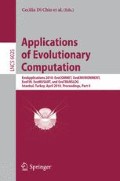Abstract
Evolutionary computation techniques are closely connected with Monte Carlo simulations via statistical mechanics. Most practical realizations of such a connection are based on Markov chain Monte Carlo procedures and Markov chain approximation methodologies. However, such realizations face challenges when we have to deal with multivariate situations. In this contribution, we consider the development of evolutionary type Monte Carlo based algorithms for dealing with jump-diffusion stochastic processes. In particular, we focus on the first passage time problems for multivariate correlated jump-diffusion processes in the context of credit risk and the analysis of default correlations. The developed technique can be useful in option pricing as well as in other areas of complex systems analysis.
Access this chapter
Tax calculation will be finalised at checkout
Purchases are for personal use only
Preview
Unable to display preview. Download preview PDF.
References
Atiya, A.F., Metwally, S.A.K.: Efficient Estimation of First Passage Time Density Function for Jump-Diffusion Processes. SIAM Journal on Scientific Computing 26, 1760–1775 (2005)
Campillo, F., Rakotozafy, R., Rossi, V.: Parallel and interacting Markov chain Monte Carlo algorithm. Mathematics and Computers in Simulation 79, 3424–3433 (2009)
Cercueil, A., Francois, O.: Monte Carlo Simulation and Population-Based Optimization. In: Int. Congress on Evolutionary Computation, CEC 2001, pp. 191–198. IEEE Press, Los Alamitos (2001)
Drugan, M.M., Thierens, D.: Evolutionary Markov chain Monte Carlo. In: Liardet, P., Collet, P., Fonlupt, C., Lutton, E., Schoenauer, M. (eds.) EA 2003. LNCS, vol. 2936, pp. 63–76. Springer, Heidelberg (2004)
Dugan, N., Erkoc, S.: Genetic algorithm-Monte Carlo hybrid geometry optimization method for atomic clusters. Computational Materials Science 45(1), 127–132 (2009)
Dukkipati, A., Bhatnagar, S., Murty, M.N.: Gelfand-Yaglom-Perez theorem for generalized relative entropy functionals. Information Sciences 177(24), 5707–5714 (2007)
Geyer, C.J.: Practical Markov Chain Monte Carlo. Statistical Science 7, 473–483 (1992)
Goswami, G., Liu, J.S., Wong, W.H.: Evolutionary Monte Carlo methods for clustering. J. of Computational and Graphical Statistics 16(4), 855–876 (2007)
Goswami, G., Liu, J.S.: On learning strategies for evolutionary Monte Carlo. Statistics and Computing 17(1), 23–38 (2007)
Johansson, A.M., Lehmann, E.A.: Evolutionary Optimization of Dynamics Models in Sequential Monte Carlo Target Tracking. IEEE Trans. on Evolutionary Computation 13(4), 879–894 (2009)
Hull, J., White, A.: Valuing Credit Default Swaps II: Modeling Default Correlations. Journal of Derivatives 8, 12–22 (2001)
Kou, S.G., Wang, H.: First passage times of a jump diffusion process. Adv. Appl. Probab. 35, 504–531 (2003)
Laskey, K.B., Myers, J.W.: Population Markov Chain Monte Carlo. Machine Learning 50(1-2), 175–196 (2003)
Melnik, R.V.N.: Coupling control and human factors in mathematical models of complex systems. Engin. Appl. of Artificial Intelligence 22(3), 351–362 (2009)
Melnik, R.V.N.: Markov chain network training and conservation law approximations: Linking microscopic and macroscopic models for evolution. Applied Mathematics and Computation 199(1), 315–333 (2008)
Silverman, B.W.: Density Estimation for Statistics and Data Analysis. Chapman & Hall, London (1986)
Song, J.H., Kiureghian, A.D.: Joint First-Passage Probability and Reliability of Systems under Stochastic Excitation. Journal of Engineering Mechanics 132(1), 65–77 (2006)
Vrugt, J.A., et al.: Accelerating Markov Chain Monte Carlo Simulation by Differential Evolution with Self-Adaptive Randomized Subspace Sampling. Int. J. of Nonlinear Sciences and Numer. Simul. 10(3), 273–290 (2009)
Wang, J., Zhang, W.-J., Liang, J.-R., et al.: Fractional nonlinear diffusion equation and first passage time. Physica A 387(1), 764–772 (2008)
Zhang, D., Melnik, R.V.N.: First passage time for multivariate jump-diffusion processes in finance and other areas of applications. Applied Stochastic Models in Business and Industry 25(5), 565–582 (2009)
Zhou, C.: An analysis of default correlation and multiple defaults. Review of Financial Studies 14, 555–576 (2001)
Zhou, C.: The Term Structure of Credit Spreads with Jump Risk. Journal of Banking and Finance 25, 2015–2040 (2001)
Author information
Authors and Affiliations
Editor information
Editors and Affiliations
Rights and permissions
Copyright information
© 2010 Springer-Verlag Berlin Heidelberg
About this paper
Cite this paper
Tsviliuk, O., Melnik, R., Zhang, D. (2010). Evolutionary Monte Carlo Based Techniques for First Passage Time Problems in Credit Risk and Other Applications in Finance. In: Di Chio, C., et al. Applications of Evolutionary Computation. EvoApplications 2010. Lecture Notes in Computer Science, vol 6025. Springer, Berlin, Heidelberg. https://doi.org/10.1007/978-3-642-12242-2_24
Download citation
DOI: https://doi.org/10.1007/978-3-642-12242-2_24
Publisher Name: Springer, Berlin, Heidelberg
Print ISBN: 978-3-642-12241-5
Online ISBN: 978-3-642-12242-2
eBook Packages: Computer ScienceComputer Science (R0)

